Readers may remember my confusion with the jubilation shown by the Spanish public over the election win by Mariano Rajoy back in November 2011. His party’s strategy during the election campaign was to say very little about what he was actually intending to do to address his country’s financial problems, preferring to simply let the incumbent party fall on its own sword so that he could take the reins. It became obvious soon after the election that, despite his party’s best efforts to dodge questions, the intention was simply to continue on the same path.
Along the way I have warned that Spain suffered from significant macroeconomic challenges that, at the time, appeared unrecognised by the markets. I also provided some analysis that the country’s problems were far greater in magnitude than something than could be fixed by simply lowering government sector deficits:
The private sector accumulated large debts on the back foreign capital inflows leading to a housing bubble. This bubble has since collapsed leaving the private sector in a position of significant wealth loss and indebtedness, the banking system holding significant and growing levels of bad debts and the economy structured around the delivery of a failed industry.
…
The growing unemployment is leading to a slowing of industrial production, which means that even though the country is importing less it also appears to be exporting less. Combine this with the interest payments on borrowings from the rest of the world and at this point Spain continues to run a current account deficit which, in the most basic terms, means Spain is still paying others more than it is being paid back. That is, the external sector is still in deficit.
So with the external sector in this state and the private sector unable and/or unwilling to take on additional debt as it attempt to mend its balance sheet after an ‘asset shock’, the only sector left to provide for the short fall in national income is the government sector. If it fails to do so then the economy will continue to shrink until a new balance is found between the sectors at some lower national income, and therefore GDP.
It may appear logical to you that this must occur, and I don’t totally disagree, but that doesn’t change the fact that under these circumstances there is simply no way that the private sector will be able to continue to make payments on the debts it has accumulated during the period of significantly higher income. This is a major unaddressed issue.
And this is the monetary trap much of the European periphery now find themselves in. Structural issues within their economies together with their pseudo non-floating currency means they are neither able to shrink nor grow out of their debts. Without significant debt restructuring they are left to flounder in a viscous spiral downwards.
The Spanish current account, led by the balance of trade, is still in the negative:
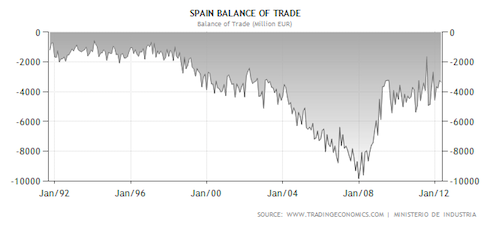
Industrial production is falling rapidly:
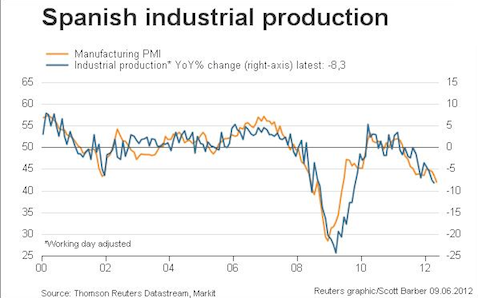
Leading business activity indicators all display further weakness:
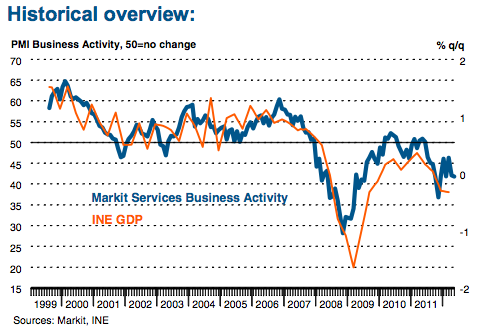
Unemployment continues to set Eurozone records:
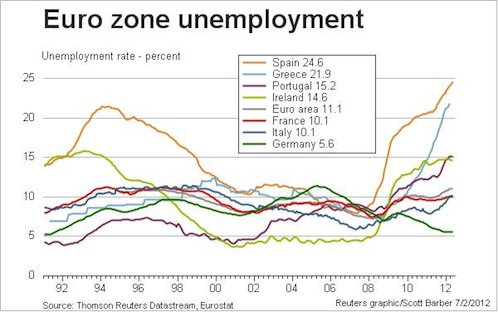
House prices continue fall, reaching -30.2% from peak in June:
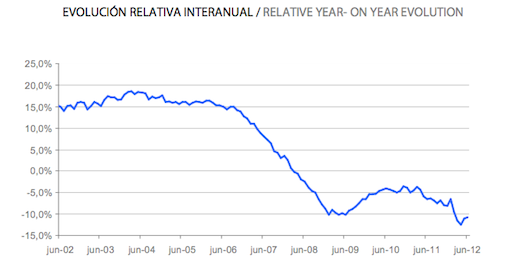
And bad debts continue to rise:
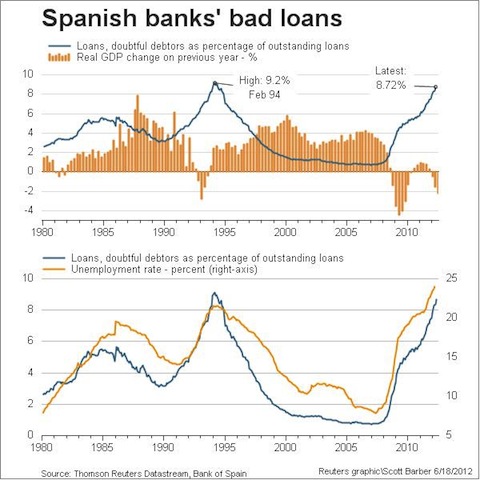
The Spanish economy is demonstrating all of the tell-tale signs of a balance sheet recession and the response to the crisis, thus far, has done little but accelerate the downturn. I’ve discussed previously this is the expected outcome from a policy response of this nature:
As we have seen from nations like Greece and Portugal, a country with a long running current account deficit and a private sector with a desire – or no choice to save (austerity) – has significant problems trying to reach a government surplus. Once you understand that the external sector and the private sector are a net drain on national income it isn’t hard to see the problem. Under these circumstances there is simply no room left in the economy for savings in the government sector and attempts to reach government surpluses become counter-productive as this simply accelerates the decline.
If a country’s current account deficit is structural ( I’ll explain this later ) then these efforts are very dangerous because this can easily develop into a damaging feedback loop. The loss of income through the external sector leads to a loss of income in the private sector, this then drives the stronger desire to save, meaning government revenues fall further. This inevitably leads to calls for higher taxes, which once again drain income from the private sector … and around we go. The result of this dynamic is a rise in unemployment, therefore national production and income, meaning once again the government sectors revenue decline while private sector spending and investment fall further.
And so to the inevitable call for higher taxes…
Overnight Mariano Rajoy announced further government cuts which, if the bond yields are anything to go by , were tentatively welcomed by the markets. Personally I see little to celebrate, as far as I can tell this is simply the marker for the next leg down of the Spanish economy:
Spanish Prime Minister Mariano Rajoy has performed an astonishing U-turn and raised VAT by 3pc.
The measure is part of a plan to cut €65bn from the struggling country’s budget over the next two-and-a-half years, and comes as hundreds of miners arrive in Madrid to protest against government cuts to subsidies.
The increase in Value Added Tax to 21pc from 18pc directly contradicts Mr Rajoy’s previous promise that he would not raise taxes.
“I said I would cut taxes and I’m raising them,” he said. “But the circumstances have changed and I have to adapt to them.”
The prime minister’s fourth austerity package in seven months will scrap a tax rebate for home buyers, scale back unemployment benefits, consolidate local governments – helping to cut €3.5bn from local authority budgets – and eliminate the year-end bonus for some public workers.
One wonders how long Mariano Rajoy has left in his political career.